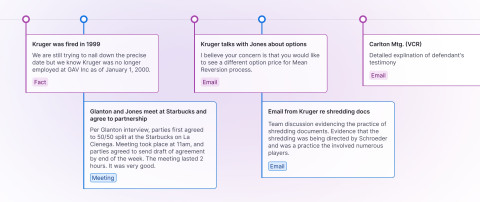
A case chronology is more than just a timeline of events. It’s a critical tool for legal teams to foster a better understanding of their case. Well-crafted chronologies can provide a tactical advantage for legal teams.
By constructing a case chronology, teams can develop a coherent case theory, reveal patterns and inconsistencies, and improve communication across clients and colleagues. Moreover, case chronologies are an important -- and often required -- part of affidavits, trial briefs, and case summaries.
While every legal team constructs chronologies for each case they work on, these chronologies are often spread out across legal briefs, documents, discovery responses, and notes. Organizing these materials can prove daunting. Here are 6 ways to simplify the process.
1. Use a standardized format
When it comes to creating a case chronology, consistency is everything. Legal teams should use templates to standardize the process. Templates should include relevant fields such as:
- Dates and times
- Parties and key people involved
- Description of the document or event
- Attorney analysis or notes
- Key issues
- Identifiers for relevant documents (e.g., control numbers, Bates numbers, exhibit numbers)
Standardization not only saves time -- it also makes it easier for anyone on the team to pick up the chronology and immediately understand the context.
2. Focus on what matters most
Chronologies are at their most useful when they are boiled down to the most essential information. Focus on legally significant events that directly support your case theory or contradict the opposing side’s. If needed, construct a supporting chronology with additional context and background details for internal use, but keep the core document streamlined.
3. Use case chronology software
Working across cumbersome spreadsheets and Word documents can make it difficult for teams to keep track of information and collaborate. Fortunately, digital platforms can streamline the process. These benefits aren’t just for your internal team. When working with co-counsel or other external collaborators, secure, cloud-based chronologies keep everyone aligned without the back-and-forth of emailed files and extra copies. Use a digital platform to build out a chronology bolstered by real-time editing, tagging, and filtering capabilities.
4. Be clear and concise
Chronologies are working tools for your legal team and serve as the source of truth for the facts of the case. Precision is critical for effective collaboration. Each entry should clearly describe the event, capture its significance to your case theory, and leave no room for misinterpretation. This ensures everyone -- whether attorneys, paralegals, or co-counsel -- is operating from the same set of facts and assumptions.
5. Treat the chronology as a living document
Though the underlying facts happened before litigation began, your understanding of those facts will evolve throughout the case. Your chronology should evolve with it. Encourage attorneys, paralegals, and support staff to add, update, and refine entries as new information comes to light. This collaborative approach reduces information silos, maintains consistency, and keeps your chronology accurate and trial-ready.
6. Link to relevant material
A strong chronology doesn’t just list facts -- it connects them to evidence. Wherever possible, link directly to deposition excerpts, exhibits, and discovery documents. This means linking to the primary document and any related documents. In a digital platform, these links allow you to move from a key fact to the underlying evidence in seconds.
Building a coherent case chronology is important for internal collaboration -- and it’s vital for teams looking to create a strong case. Whether your team is prepping for trial or organizing facts during discovery, an orderly and accurate chronology can make or break the process.

